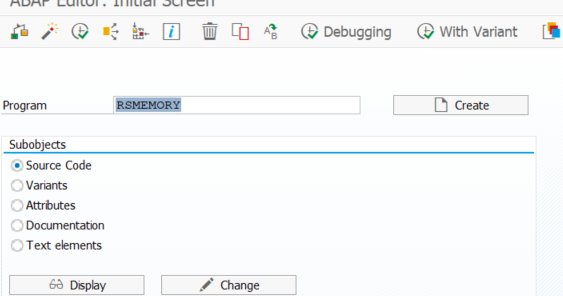- Sap Parameter Values
- Sap Extended Memory Parameter
- Sap Extended Memory Parameter Example
- Sap Extended Memory Parameters
- This is a Memory area that belongs to the Extended Memory (EM). The goal of this Wiki is to explain what are the memory parameter that determine the total size of EG memory. Extend Global Memory area The size of the EG is obtained from the total of the parameter values.
- In the Application Server ABAP (AS ABAP), the zero administration memory management (ZAMM) is used. Here, the default values of the profile parameters in SAP Memory Management are derived with formulas by using the value of the central profile parameter PHYSMEMSIZE.
Parameter
Extended memory is defined by the SAP parameter “em/initialsizeMB” and the user quota for dialog work process is defined by the parameter “ztta/rollextensiondia”. If this memory is not sufficient then, 3. The rest of the roll area is used.
em/global_area_MB
Short text
Size of the extended global memory area in MB
Parameter Description
This value specifies the maximum size of the part of extended memory (see also parameter em/initial_size_MB or em/address_space_MB) that is reserved for global data, that is, user-independent and work process-independent data.
Application Area
Extended Memory
Parameter Unit
Megabytes
Default Value
Approximately 96 MB (platform-dependent)
Who is permitted to make changes?
Customer
Are other parameters affected or dependent?

Sap Parameter Values
The parameter should normally have a value of approximately 5-10% of the value of em/initial_Size_MB, though you may have to set it to a different value depending on the requirements of your application programs.
Parameter
em/initial_size_MB
Short text
Extended Memory Size
Parameter Description
Note the operating system dependency for Microsoft Windows.
The value specifies the initial size of the memory area that SAP Memory Management manages as extended memory. The memory requirements for interactive users’ programs are met from this area. This memory type can be assigned very quickly to changing work processes by mapping and therefore allows very fast context switches.
Aim
Ideally, this pool should be large enough to contain the total of all user contexts, so that context switching for all users could be performed at optimal speed. You can restrict the maximum usage of an individual user with the parameter ztta/roll_extension. This prevents one user or a small number of users using all of the extended memory. If the extended memory is exhausted, additional memory requests are satisfied from the roll area and then from from the local address area of a work process (heap, malloc). The data in the roll area must be copied during the context switch, while the data in the local process area leads to exclusive reservation of the entire work process (PRIV mode).
Parameter Unit
1 MB
Default Value
Platform-dependent, approximately 4 GB for 64-bit
Default Value
(other)
500 – 4096, in extreme cases much higher
• Around 5 MB x number of active users on the application server
• Additional tuning in accordance with the values from transaction ST02 (for individual application servers) or RZ03 (for all application servers)
• From values > 500, you should expect operating system restrictions that cannot be extended, particularly in 32 bit systems.
Default Value
(Microsoft Windows and Linux)
Do not change the default = PHYS_MEMSIZE manually, since extended memory increases dynamically when necessary. No further calculation or adjustment is necessary.
Who is permitted to make changes?
The customer. No manual maintenance is necessary for Microsoft Windows or Linux.
Are other parameters affected or dependent?

The value must be smaller than or equal to ( em/blocksize_KB * 16) and an integer multiple of (em/blocksize_KB / 1024).
Operating System Restrictions
The swap space must be large enough and should have a safety net of several hundred megabytes at all times. Use transactions ST06 and RZ03 (CCMS alerts) for monitoring. You may have to extend existing limits in the operating system:
• Maximum size of shared memory, mapped file, mprotect
• Address space limits for each process or in total
• You can use the test program ‘memlimits’ to determine some of these limitations.
Microsoft Windows
A dynamic extension of the extended memory is implemented under Microsoft Windows and Linux. This means that if the current extended memory is insufficient, it is increased in steps of MAX (size [PHYS_MEMSIZE / 2], 2 GB). As a result of this mechanism, it is no longer necessary to maintain this profile parameter manually.
Example
Application server with 1 GB main memory. PHYS_MEMSIZE is not maintained and its default value is the size of the main memory. Therefore, the initial size of the extended memory = 1 GB. If this size is not sufficient, the extended memory is increased in 500 MB steps until the maximum size em/max_size_MB (default for Microsoft Windows: 1.5 * PHYS_MEMSIZE), or until there is no further capacity in the address space and in the Microsoft Windows paging file.
Sap Extended Memory Parameter
Application server with 8 GB of main memory, PHYS_MEMSIZE is not set. Initially, 5.6 GB of memory is allocated for extended memory. If this area is exhausted, the extended memory is extended in 2 GB steps until the free available memory in the operating system (free space in the paging file + free space in memory) is exhausted, or until em/max_size_MB is reached.
Central instance with 1 GB main memory. The database uses 400 MB and the SAP instance 600 MB of main memory. The value for PHYS_MEMSIZE is set to 600 in the instance profile. This means that the extended memory has an initial size of 600 MB, and if necessary extends itself in steps of 300 MB.
Database System Restrictions
None
Sap Extended Memory Parameter Example
Database System Restrictions
Sap Extended Memory Parameters
None